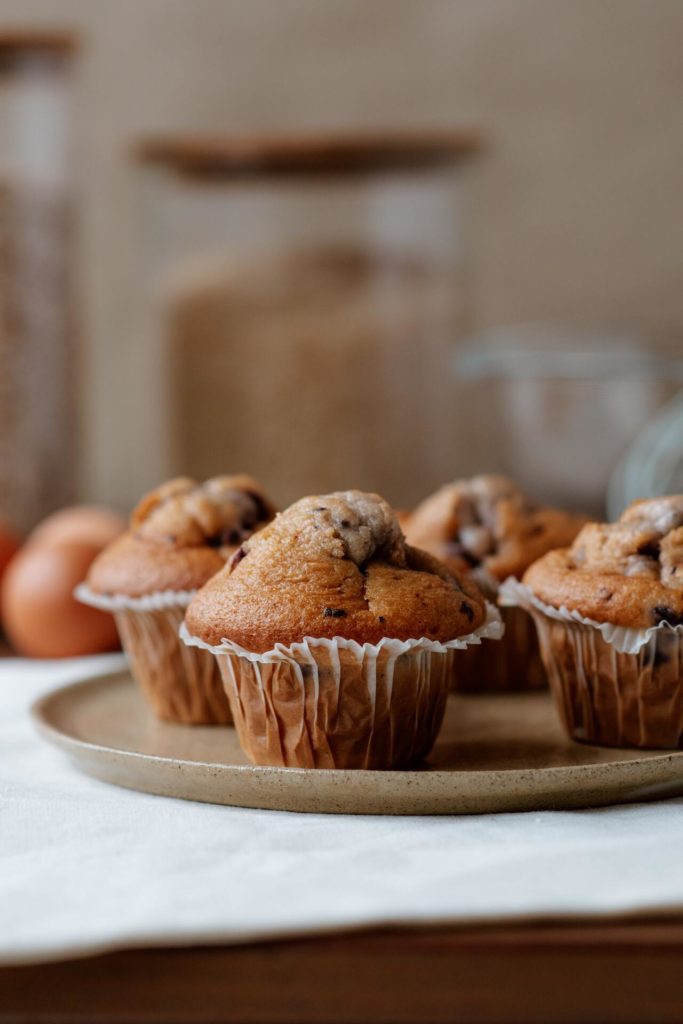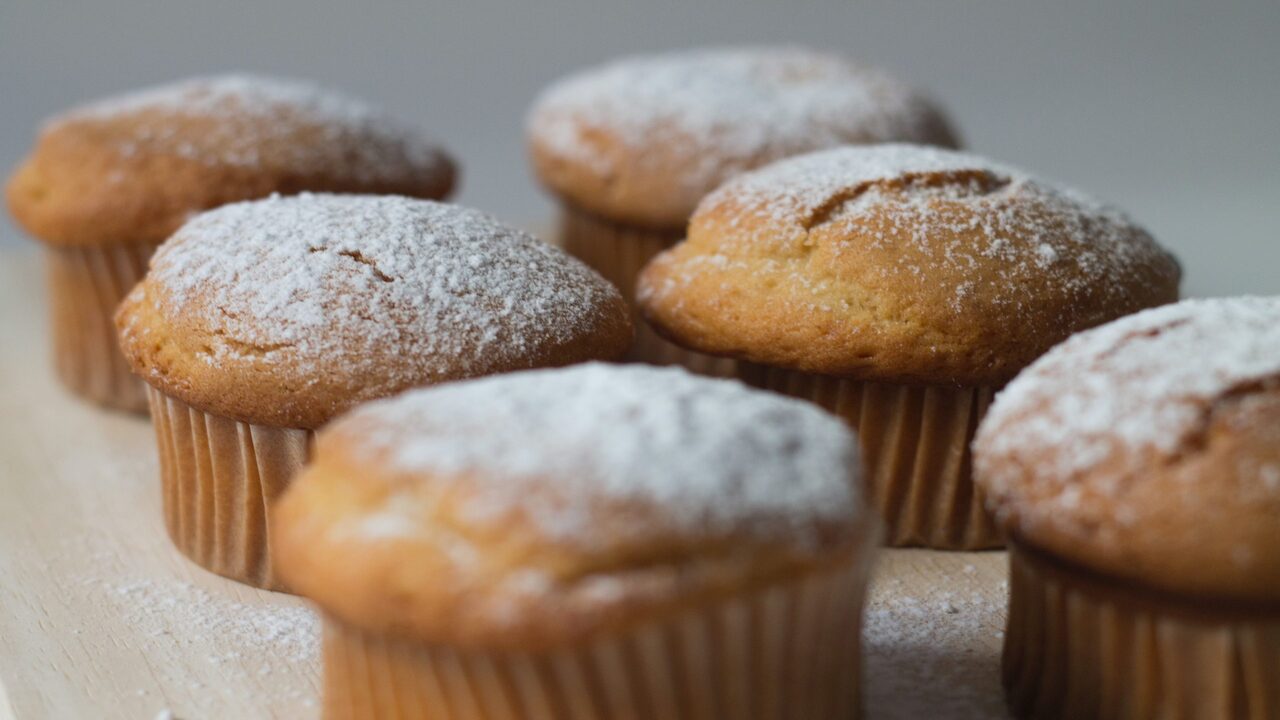An individual-sized baked product, the homemade muffin is very versatile and works in various ways. It can be flavored with chocolate chips, frozen, dry fruits, nuts, vegetables, creams, and much more.
It is perfectly possible to work with infinite flavor variations to snack on for breakfast, birthdays, desserts, take on a picnic, or gift someone.
Muffins are usually enjoyed in the winter – split, toasted, buttered, and served hot for tea, and sometimes with jam.
-JENIFER HARVEY Lang- restaurateur and writer
Jump To Section
- What Is a Muffin?
- The Origin
- English Vs. North American Muffins
- The Differences between Muffins and Cupcakes
- 9 Tips to Customize a Homemade Muffin
- 15 Most Popular Muffin Combinations
- 8 Easy Steps To a Master Recipe
What Is A Muffin?
Muffin with chocolate chips and powdered sugar
A muffin is an individual-sized, baked cake, sweetened or not.
It can refer to two distinct items, a cupcake-like quick-bread, chemically leavened and baked in a mold, or a part-raised flatbread baked and then cooked on a griddle.
There are savory varieties like corn and cheese or sweet, such as blueberry, chocolate chip, lemon, and banana.
A real muffin is light and moist from the inside with plain or crisp tops.
The Origin
Research suggests that “muffin” may be related to the Greek bread “maphula”, a cake baked on a hearth or griddle.
The quickbread originated in North America during the 19th century, while the flatbread is British and dates from the early 18th century.
The word’s origin, “muffin,” is uncertain. It is possibly derived from the German “muffe,” meaning a small cake. It is also connected to the Old French “moufflet,” meaning soft.
See what food writers are saying about the origin of the muffin.
“In Great Britain, during the Victorian era, muffins were most popular and bought in the street from sellers who carried trays of them on their heads, ringing bells.” Larousse Gastronomique, Jenifer Harvey Lang
“The origins of the word are obscure, but possibly it is from Low German muffe [meaning] cake. The term was first printed in English in 1703, and Hannah Glasse’s 1747 cookbook gives a recipe for making muffins.” Encyclopedia of American Food and Drink, John F. Mariani
“Muffin is a term connected with moufflet, an old French word applied to bread, meaning soft. The word muffin first appeared in print in the early 18th century, and recipes began to be published in the middle of the 18th century.” Oxford Companion to Food, Alan Davidson
Over the years, the size of the muffins and the number of calories have changed: the 3-inch “ancestor” had only 120 to 160 calories, while today’s giant-sized one contains 340 to 630 calories each.
English Vs. North American Muffins
English
The English style is small, round, and flat, and uses yeast as a leavening agent, which consumes more time in the preparation.
It is commonly sliced horizontally, toasted, buttered, or used as bread in various breakfast sandwiches.
North American
In North America, it is different. Most American and Canadian cooks prefer quick recipes.
Therefore, the favorite leavening agents are baking powder and baking soda instead of yeast, allowing it to be prepared in 45 min to 1 hour.
Some cities in the United States adopted “The Official State Muffin” as follows:
New York
The apple muffin earned the official state of New York in 1987 due to students’ efforts across New York State.
Massachusetts
In 1986, the corn muffin, a staple of New England cuisine, became the official state of Massachusetts after a petition by schoolchildren.
Minnesota
The blueberry muffin has been the official state of Minnesota since 1988, after third-grade children at South Terrace Elementary School in Carlton, MN, applied for the state legislature.
The Differences Between Muffins And Cupcakes
Sizes
Both are the same size.
Mini – 1″ diameter
Standard – 2″ x 1 1/4″ diameter
Jumbo – 3 1/2″ diameter
Ingredients
Muffins and cupcakes usually contain flour, milk, eggs, fat (butter or vegetable oil), and sugar.
Some recipes suggest using all-purpose, whole wheat, or oat flour. Others recommend replacing butter with vegetable oil or vice versa.
Feel free to use nuts, chocolate chips, and fresh or dried fruit for the filling.
The Batter
Muffins: The batter is basically a mix of dry and liquid ingredients beaten for a short time and remains relatively lumpy.
Cupcakes: The creaming method is used to beat the batter longer to emulsify and aerate, making the cupcakes smoother and fluffy.
Visual
You don’t need to be an expert in the bakery, as the most apparent difference is visual.
Cupcakes usually have a head or top no larger than the body, while muffins are often encouraged to overflow from the baking cup, resulting in a mushroom shape.
Summing up, cupcakes are miniature cakes, always with frosting, and, due to the high sugar content, they can be served as a dessert, but not as a daily breakfast item like muffins, which have discreet toppings of chestnut crumble or nuts.
9 Tips To Customize Homemade Muffins
- Replace all-purpose flour with oat flour, mixing with the dry ingredients first.
- Incorporate all liquid extracts, purées, or other mashed ingredients, into the wet ingredients. An essential tip for adding ingredients is to combine “like with like.”
- In a gentle folding motion, incorporate the solid mix-ins into the batter until homogenized. Do not overwork the batter.
- For a more cake-like texture, replace the vegetable oil with butter and gently increase the amount of sugar.
- Prefer to incorporate the batter by hand, avoiding over-mixing.
- Add mix-ins to the batter after combining all dry and liquid ingredients in a folding motion.
- To not sink the mix-in into the pan while baking, sprinkle flour over the ingredients, such as chocolate chips or fresh fruit.
- Do not thaw the berries, or it will color the batter.
- Use an ice cream scoop to portion the batter evenly into the pan.
15 Most Popular Muffin Combinations
The master muffin recipe works for infinite variations of flavors. Check out the most popular:

- Apple Cinnamon
- Apple Crumble
- Blueberry
- Banana Nut
- Carrot-Raisin
- Carrot with walnuts
- Chocolate Chip
- Cranberry
- Cranberry Pumpkin
- Double Chocolate
- Honey
- Lemon Poppy Seed
- Pumpkin and Cream Cheese
- Raspberry Nut
- Strawberry and Cream
8 Easy Steps To A Master Recipe
These simple yet sophisticated muffins are not only eye-catching but bursting with flavor.
Now, get to work! 😋

A Master Recipe Of Muffin
Equipment
- Mixing Bowls
- Whisk
- Wooden Spatula
- Muffin pan
- Ice Cream Scoop optional
Ingredients
- 450 g Flour
- 120 g Sugar
- 5 g Baking powder
- 5 g Baking Soda
- pinch Salt
- 1 pc Egg
- 500 ml Milk
- 120 ml Vegetable oil
- 5 ml Vanilla extract
Instructions
- Preheat the oven to 350ºF / 175ºC

- Grease the muffin pan with butter or line with paper liners.
- Combine all dried ingredients well: flour, baking powder, baking soda, salt, and sugar.
- In another bowl, mix together the milk, egg, oil and vanilla extract.
- Pour the liquid mixture into the dry ingredients bowl and beat until just combined.
- Fill about ⅔ full using an ice-cream scoop
- Bake for about 20-25 min until golden brown and a toothpick inserted in the center comes out clean.
- Allow the muffins to cool for 5 min then transfer to a plate.
Notes
Access: Eggs: Everything You Need to Know Before Cracking Them
Did you make this recipe?
Leave a comment below and share our content.
Please help our community grow by following our social media on Spotify, Instagram, Facebook, YouTube, and TikTok. And stay up to date with the news from the world of Gastronomy.
Don’t forget to tag @gastrovinoacademy on Instagram and hashtag it #gastrovinoacademy.
Cheers 🍷



